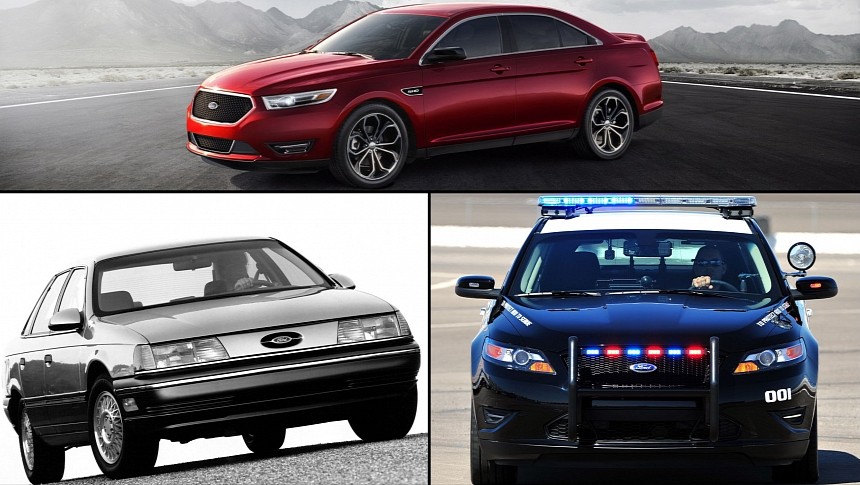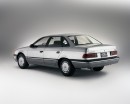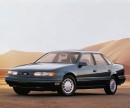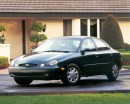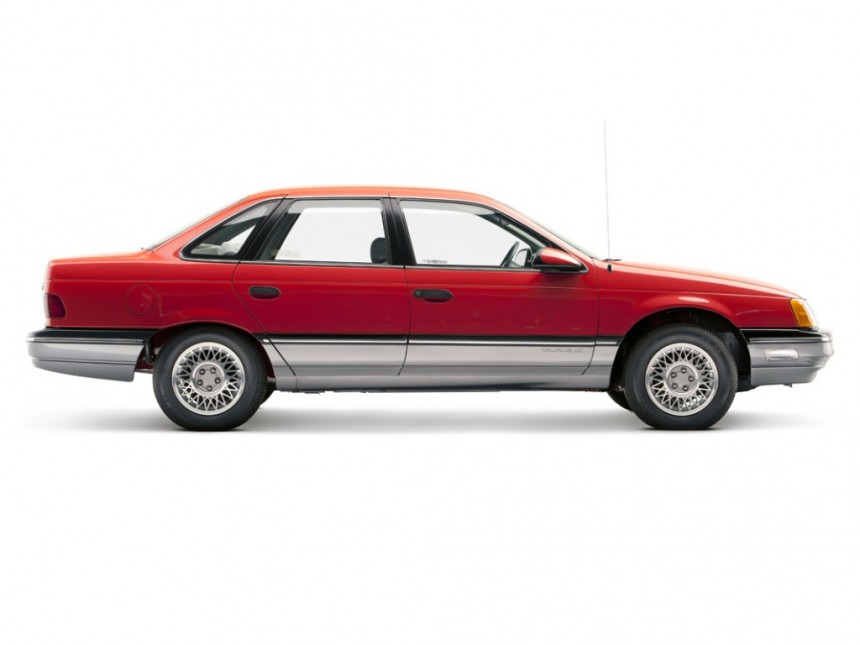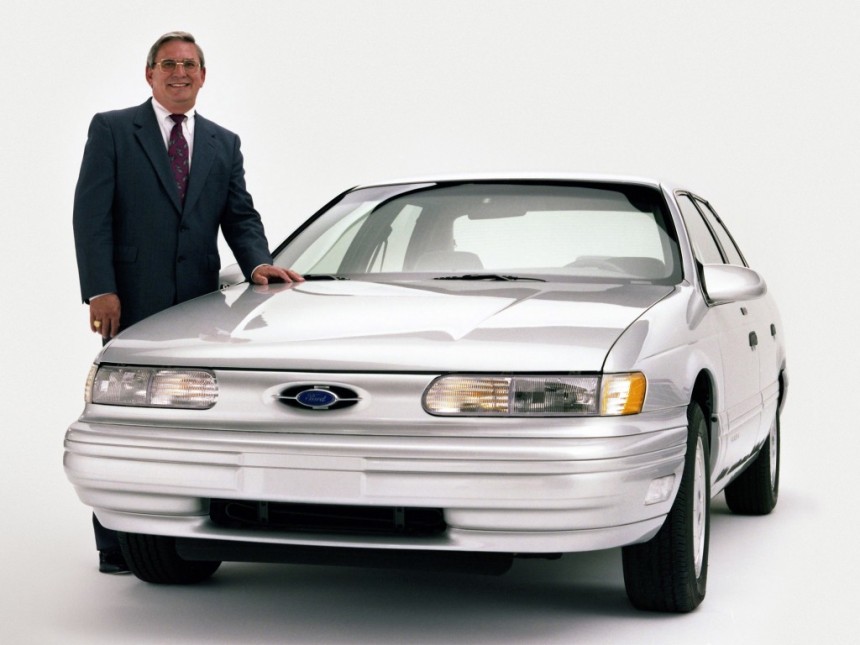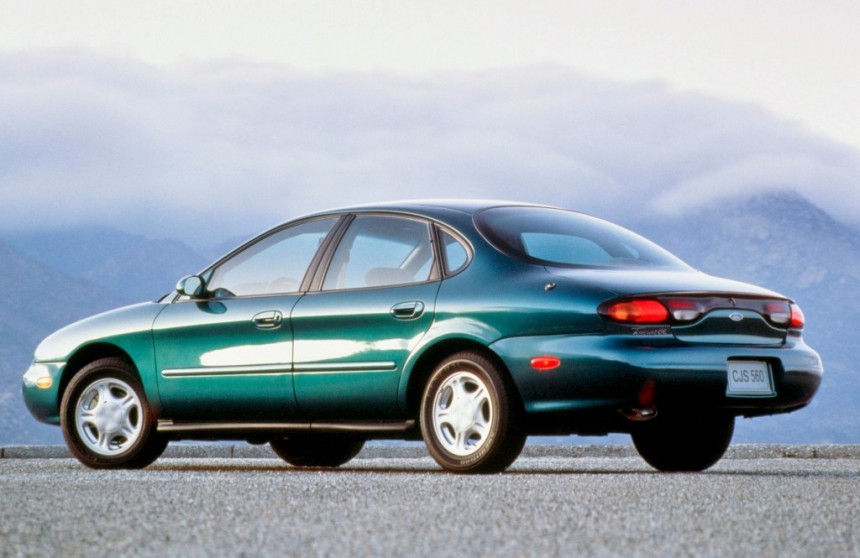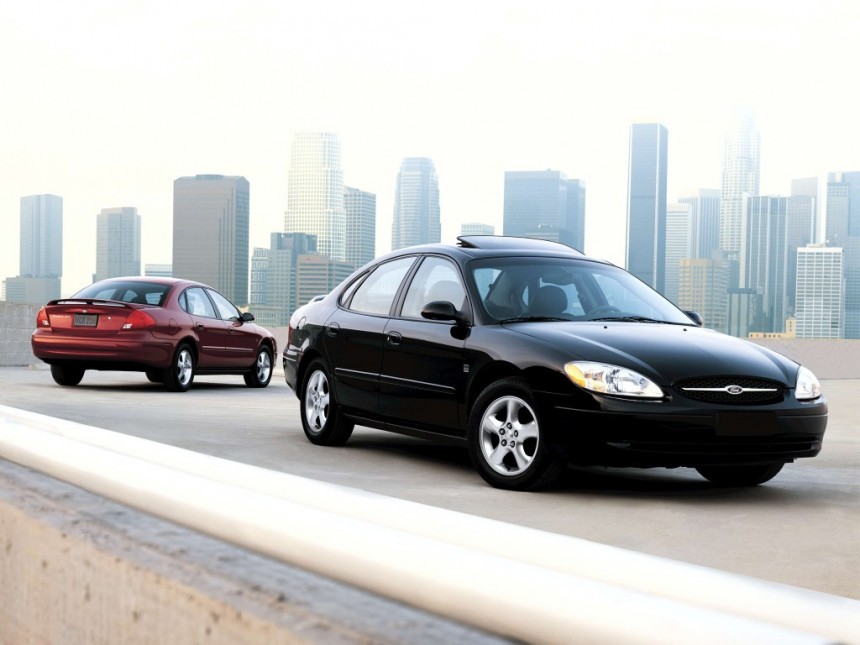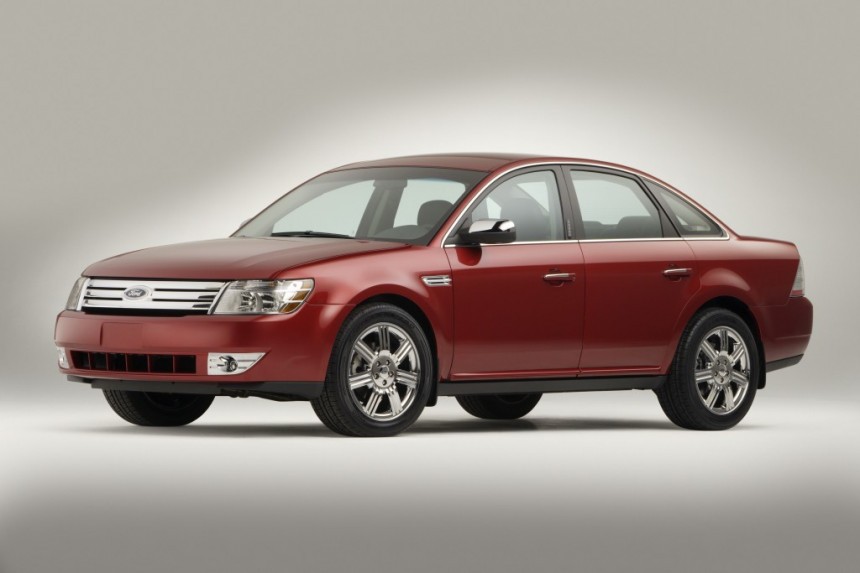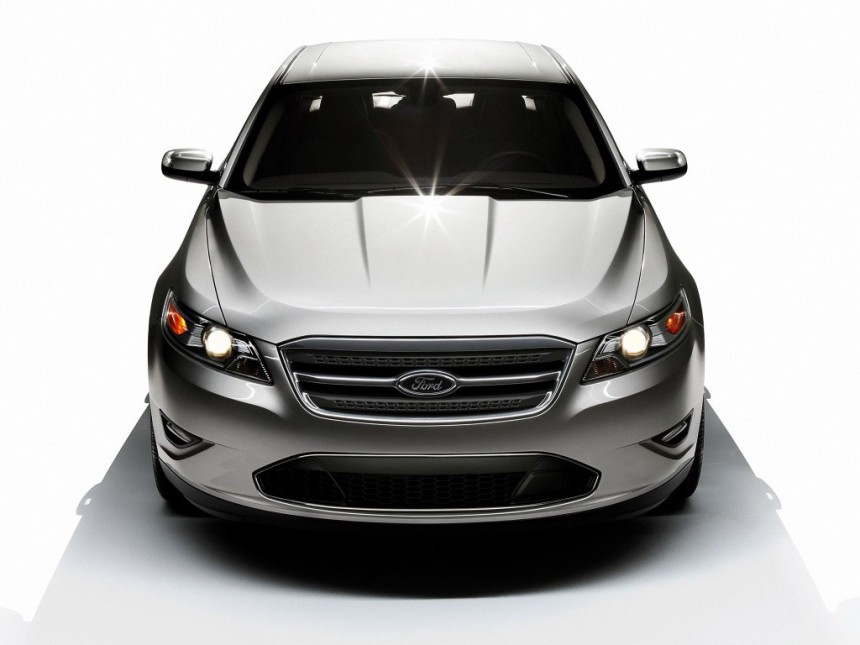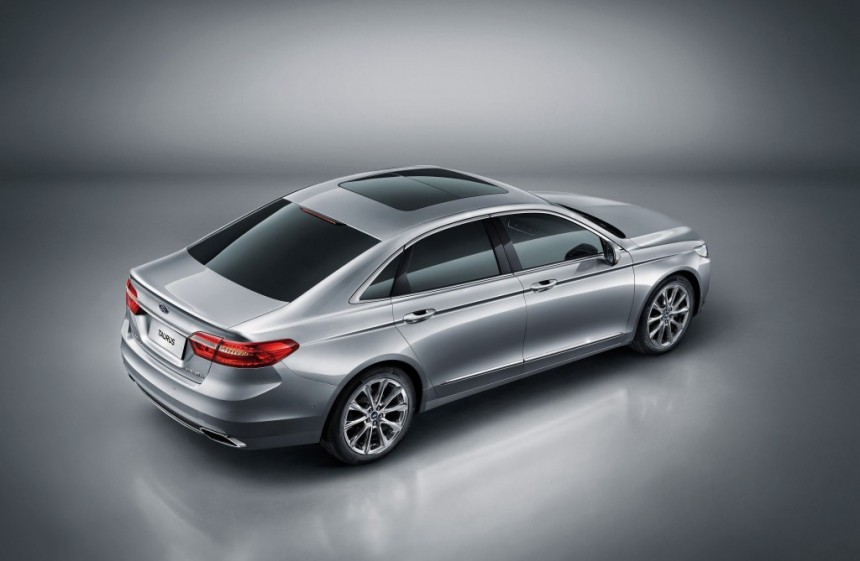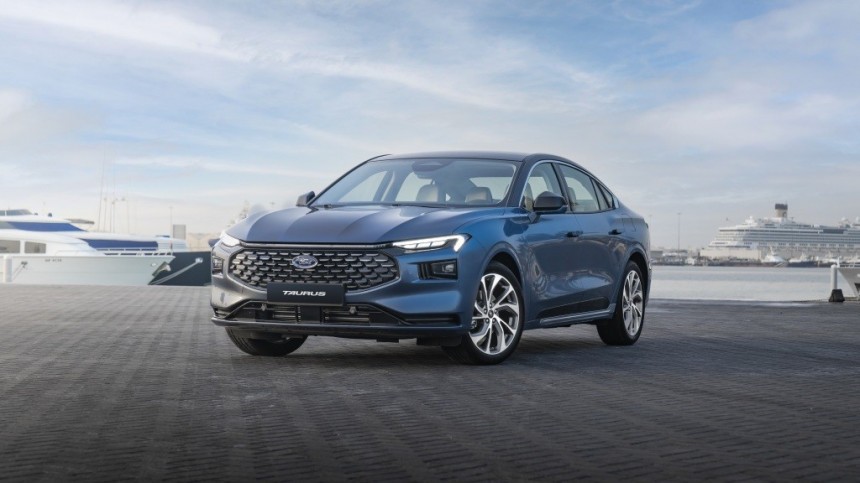1970s car styling is defined by straight lines and – therefore – boxiness. The wedge-shaped craze was in full swing as well, with three Italian designers defining this genre by means of mid-engine masterpieces such as Fioravanti's 512 BB, Giugiaro's Esprit, and Gandini's Countach. When the 1980s rolled around, curves became fashionable again despite curves not being a novel idea in this particular industry. 1930s Chrysler and DeSoto Airflow, anyone? The Beetle? Traction Avant?
Ford is the automaker that made the curve-heavy aesthetic cool again, with Uwe Bahnsen's 1982 Sierra coming to mind. The jelly mold styling was ultimately adopted by other automakers, with an emphasis on aero to minimize wind noise and to improve fuel economy.
Although not as apparent as in the Sierra's case, the first-generation Taurus is noticeably curvier and more aerodynamic than the Fox-body LTD. Unveiled in 1985 to mixed reception, the Taurus will be forever associated with the futuristic car in RoboCop, a dystopian movie conceived by Edward Neumeier while unofficially working on the set of Blade Runner. All things cyberpunk boomed in the 1980s, including in Japan, where Akira received an anime adaptation in 1988.
Beyond its forward-looking design, rise to fame in RoboCop, and its eventual adoption as a police car throughout the United States of America, the Taurus is also credited for saving Ford in the mid-1980s and for making sedans exciting again with the high-performance version dubbed SHO. That being said, let's delve deeper into the Taurus' near four-decade-long journey from yardstick to just a rebadged Mondeo.
On sale for the 1986 model year, the original replaced the mid-size LTD. Rather than the rear-wheel-drive platform of its predecessor, the newcomer switched to front-wheel drive because that was the preferred layout following the 1973 and 1979 energy crises. Chrysler offered plenty of K-platform cars at the time, and GM boasted the X-body Citation and A-body Celebrity.
A significant automobile for that decade, together with the likes of the Chrysler minivan and Group B homologation specials like the Lancia Delta Integrale, the Taurus is twinned with the Mercury Sable. The replacement for the Marquis left us in 2009, two years before Blue Oval discontinued the Mercury division.
Despite some undeserved criticism from the media and public alike, the Taurus proved the naysayers wrong by selling more than 200,000 units in the first model year. The Super High Output performance variant launched for the 1989 model year with a high-tech powerplant designed by Yamaha. Loosely related to the 3.0-liter Vulcan, the V6 in question flaunts Yamaha heads of the DOHC variety and a stronger engine block to boot.
The second-generation Taurus followed in the footsteps of the original with four-door sedan and five-door station wagon body styles. Remember when wagons actually sold well? Pepperidge Farm remembers…
Still based on the DN5 architecture of the first generation, the second is often described as nothing more than a heavy facelift. Given that the wagon is carryover from the B pillars back, the critics aren't entirely wrong. Offered with the Vulcan and Essex sixers in combination with a four-speed automatic, the Gen 2 sold a whopping 410,000 units in the first year of production. Can you imagine a sedan selling this many copies in the US of A today? The current leader is the Camry, which moved 295,201 examples in 2022.
Launched right after the standard Taurus, the second-generation SHO carried over the first gen's engine and transmission. Come 1993, the five-speed manual was joined by an optional four-speed automatic that was paired to a 3.2-liter version of the Yamaha V6. The manual-equipped SHO came with a 3.0-liter mill.
The DN5 platform was revised to a great degree for the 1996 model year Taurus, becoming the DN101. The Dearborn-based automaker worked its magic on the DN5-derived WIN88 platform as well, turning it into the V platform for the second-gen Windstar minivan.
More rounded than its predecessor, this generation of the Taurus went crazy with oval shapes for both the exterior and interior. Even the rear window was oval, much to the discontent of prospective customers. After being crowned the best-selling car in the US in 1996, the Ford Taurus lost its crown to the Toyota Camry in 1997.
As opposed to the 3.0- and 3.2-liter V6 engines of prior SHOs, the third gen rolled out in 1996 with more displacement and cylinders. Also designed by Yamaha, the Super Hight Output 3.4-liter V8 is notorious for cam sprocket failures. The second-largest automaker in the US famously issued a technical service bulletin in which it prescribed the application of Loctite (!!!) to prolong the life of the camshafts. It didn't work, though…
This fellow is a low point in the Taurus' history. Not only does it feature yet another DN5-derived platform, but Ford couldn't make a case for the Super High Output due to – drum roll, please – worsening sales. It was so bad that the 2007 model year Taurus was for fleets only.
On the upside, the design was reassuringly subdued. This was the New Edge era, with said styling language being introduced by the GT90 in 1995 and the Ka city car in 1996. Come 2006, Kinetic Design replaced New Edge, starting with the Galaxy and S-Max minivans.
Three nameplates would simultaneously replace the Taurus in the automaker's North American lineup: the Five Hundred and Fusion for the sedan, and the Freestyle for the wagon. Under the leadership of Alan Mulally, the Ford Motor Company brought back the Taurus into the fold after a short hiatus. The mid-cycle refresh of the Five Hundred received the Fusion moniker due to the full-size Five Hundred's weak brand equity.
A full-size sedan beginning with the 2008 model year, the Taurus ultimately replaced the Crown Victoria as the Blue Oval's flagship sedan. Production came to a grinding halt after the 2009 model year, with this generation of the Ford Taurus selling rather poorly.
Remember the Freestyle? It was replaced by the Taurus X. Despite being a crossover, sales were underwhelming at best. Even though Mulally-led Ford weathered the 2007 – 2008 financial crisis admirably well, his decision to revive the Taurus nameplate just didn't work out.
The Taurus X topped 23,112 sales in the United States market in calendar year 2008. As for the sedan, make that 52,667 in the first full calendar year of production. Unfortunately, the writing was already on the wall.
Sales rebounded to nearly 69,000 units in 2010 with the sixth generation, a far cry from the 410,000 of the Gen 2 in its first year of production. Unfazed by this worrying trend, the Ford Motor Company pushed things forward by introducing the Police Interceptor Sedan as the Crown Victoria Police Interceptor's heir apparent.
The SHO returned as well, packing a Ford-developed V6 of the twin-turbo variety. The 3.5-liter EcoBoost belts out a respectable 365 horsepower and 350 pound-feet (475 Nm) of twist. Only available with a six-speed automatic, the SHO was featured in Men in Black 3.
Based on the D3 platform derived from the Volvo P2, the Taurus received plenty of flak from the motoring media for things ranging from unresponsive steering to cheap interior plastics. Worsening sales eventually forced the Ford Motor Company to announce its discontinuation in April 2018, together with the Fiesta, Focus, and Fusion. The only car that Ford sells in North America as of April 2023 is the Mustang. The Fusion and Focus, however, live on overseas. The Fiesta will be discontinued sometime this year due to the rising popularity of crossovers and the American automaker's all-electric push in the European Union and the UK.
Wait, how come there's a Gen 7 if the Taurus was discontinued after the 2019 model year? The answer is China, where the Changan Ford joint venture produced this variant between 2015 and 2022. Developed with the help of Ford's Australian division, the four-door sedan uses the CD4 platform of the Fusion (a.k.a. Mondeo).
The seventh generation started exports in 2020, but only in Middle Eastern countries. An extended-wheelbase Mondeo and a watered-down Lincoln Continental in equal measure, this particular Taurus came with six- and eight-speed automatics connected to four- and six-cylinder lumps. Believe it or not, the base engine was an underpowered 1.5L inline-four. Preposterous, innit?
Higher up the spectrum, a 2.0-liter turbo produced 245 hp and 258 pound-feet (350 Nm). As for the range-topping engine, the 2.7-liter EcoBoost V6 was rated at 325 hp and 350 lb-ft (475 Nm) in this application.
Manufactured by Changan Ford at the Chongqing factory in China, the fifth-generation Mondeo is dubbed Taurus in the Middle East. Closely related to the Lincoln Z for China, the Taurus now rides on the C2 platform of the Focus, Escape, Bronco Sport, and Maverick.
Remarkably similar to the Ford Evos up front, the Taurus comes in three flavors: Ambiente, Trend, and Titanium. All three are equipped with a 2.0-liter turbo and eight-speed automatic, driving the front wheels. Rated at 229 horsepower and 286 pound-feet (388 Nm), the Taurus is available in a grand total of five exterior colors.
Sophisticated on the outside and techy inside, the eighth-generation Taurus is probably going to be the last of its kind as crossovers continue to gain market share in both China and the Middle East. The tragedy isn't that the Taurus' days are number. The real tragedy is that Ford failed to replicate the specialness of the original, designed with great care and detail under the quality culture championed by then chairman Donald Petersen.
Although not as apparent as in the Sierra's case, the first-generation Taurus is noticeably curvier and more aerodynamic than the Fox-body LTD. Unveiled in 1985 to mixed reception, the Taurus will be forever associated with the futuristic car in RoboCop, a dystopian movie conceived by Edward Neumeier while unofficially working on the set of Blade Runner. All things cyberpunk boomed in the 1980s, including in Japan, where Akira received an anime adaptation in 1988.
Beyond its forward-looking design, rise to fame in RoboCop, and its eventual adoption as a police car throughout the United States of America, the Taurus is also credited for saving Ford in the mid-1980s and for making sedans exciting again with the high-performance version dubbed SHO. That being said, let's delve deeper into the Taurus' near four-decade-long journey from yardstick to just a rebadged Mondeo.
Ford Taurus Gen 1
A significant automobile for that decade, together with the likes of the Chrysler minivan and Group B homologation specials like the Lancia Delta Integrale, the Taurus is twinned with the Mercury Sable. The replacement for the Marquis left us in 2009, two years before Blue Oval discontinued the Mercury division.
Despite some undeserved criticism from the media and public alike, the Taurus proved the naysayers wrong by selling more than 200,000 units in the first model year. The Super High Output performance variant launched for the 1989 model year with a high-tech powerplant designed by Yamaha. Loosely related to the 3.0-liter Vulcan, the V6 in question flaunts Yamaha heads of the DOHC variety and a stronger engine block to boot.
Ford Taurus Gen 2
Still based on the DN5 architecture of the first generation, the second is often described as nothing more than a heavy facelift. Given that the wagon is carryover from the B pillars back, the critics aren't entirely wrong. Offered with the Vulcan and Essex sixers in combination with a four-speed automatic, the Gen 2 sold a whopping 410,000 units in the first year of production. Can you imagine a sedan selling this many copies in the US of A today? The current leader is the Camry, which moved 295,201 examples in 2022.
Launched right after the standard Taurus, the second-generation SHO carried over the first gen's engine and transmission. Come 1993, the five-speed manual was joined by an optional four-speed automatic that was paired to a 3.2-liter version of the Yamaha V6. The manual-equipped SHO came with a 3.0-liter mill.
Ford Taurus Gen 3
More rounded than its predecessor, this generation of the Taurus went crazy with oval shapes for both the exterior and interior. Even the rear window was oval, much to the discontent of prospective customers. After being crowned the best-selling car in the US in 1996, the Ford Taurus lost its crown to the Toyota Camry in 1997.
As opposed to the 3.0- and 3.2-liter V6 engines of prior SHOs, the third gen rolled out in 1996 with more displacement and cylinders. Also designed by Yamaha, the Super Hight Output 3.4-liter V8 is notorious for cam sprocket failures. The second-largest automaker in the US famously issued a technical service bulletin in which it prescribed the application of Loctite (!!!) to prolong the life of the camshafts. It didn't work, though…
Ford Taurus Gen 4
On the upside, the design was reassuringly subdued. This was the New Edge era, with said styling language being introduced by the GT90 in 1995 and the Ka city car in 1996. Come 2006, Kinetic Design replaced New Edge, starting with the Galaxy and S-Max minivans.
Three nameplates would simultaneously replace the Taurus in the automaker's North American lineup: the Five Hundred and Fusion for the sedan, and the Freestyle for the wagon. Under the leadership of Alan Mulally, the Ford Motor Company brought back the Taurus into the fold after a short hiatus. The mid-cycle refresh of the Five Hundred received the Fusion moniker due to the full-size Five Hundred's weak brand equity.
Ford Taurus Gen 5
Remember the Freestyle? It was replaced by the Taurus X. Despite being a crossover, sales were underwhelming at best. Even though Mulally-led Ford weathered the 2007 – 2008 financial crisis admirably well, his decision to revive the Taurus nameplate just didn't work out.
The Taurus X topped 23,112 sales in the United States market in calendar year 2008. As for the sedan, make that 52,667 in the first full calendar year of production. Unfortunately, the writing was already on the wall.
Ford Taurus Gen 6
The SHO returned as well, packing a Ford-developed V6 of the twin-turbo variety. The 3.5-liter EcoBoost belts out a respectable 365 horsepower and 350 pound-feet (475 Nm) of twist. Only available with a six-speed automatic, the SHO was featured in Men in Black 3.
Based on the D3 platform derived from the Volvo P2, the Taurus received plenty of flak from the motoring media for things ranging from unresponsive steering to cheap interior plastics. Worsening sales eventually forced the Ford Motor Company to announce its discontinuation in April 2018, together with the Fiesta, Focus, and Fusion. The only car that Ford sells in North America as of April 2023 is the Mustang. The Fusion and Focus, however, live on overseas. The Fiesta will be discontinued sometime this year due to the rising popularity of crossovers and the American automaker's all-electric push in the European Union and the UK.
Ford Taurus Gen 7
The seventh generation started exports in 2020, but only in Middle Eastern countries. An extended-wheelbase Mondeo and a watered-down Lincoln Continental in equal measure, this particular Taurus came with six- and eight-speed automatics connected to four- and six-cylinder lumps. Believe it or not, the base engine was an underpowered 1.5L inline-four. Preposterous, innit?
Higher up the spectrum, a 2.0-liter turbo produced 245 hp and 258 pound-feet (350 Nm). As for the range-topping engine, the 2.7-liter EcoBoost V6 was rated at 325 hp and 350 lb-ft (475 Nm) in this application.
Ford Taurus Gen 8
Remarkably similar to the Ford Evos up front, the Taurus comes in three flavors: Ambiente, Trend, and Titanium. All three are equipped with a 2.0-liter turbo and eight-speed automatic, driving the front wheels. Rated at 229 horsepower and 286 pound-feet (388 Nm), the Taurus is available in a grand total of five exterior colors.
Sophisticated on the outside and techy inside, the eighth-generation Taurus is probably going to be the last of its kind as crossovers continue to gain market share in both China and the Middle East. The tragedy isn't that the Taurus' days are number. The real tragedy is that Ford failed to replicate the specialness of the original, designed with great care and detail under the quality culture championed by then chairman Donald Petersen.
